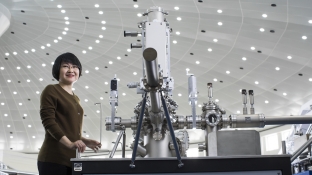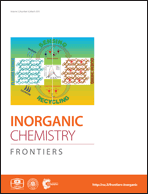This month sees the following articles in Inorganic Chemistry Frontiers that are in the top 10 most accessed from October– December:
Visible-light radical reaction designed by Ru- and Ir-based photoredox catalysis
Takashi Koike and Munetaka Akita
Inorg. Chem. Front., 2014,1, 562-576
DOI: 10.1039/C4QI00053F
Rational construction of metal–organic frameworks for heterogeneous catalysis
Sha Ou and Chuan-De Wu
Inorg. Chem. Front., 2014,1, 721-734
DOI: 10.1039/C4QI00111G
Routes to tin chalcogenide materials as thin films or nanoparticles: a potentially important class of semiconductor for sustainable solar energy conversion
David J. Lewis, Punarja Kevin, Osman Bakr, Christopher A. Muryn, Mohammad Azad Malik and Paul O’Brien
Inorg. Chem. Front., 2014,1, 577-598
DOI: 10.1039/C4QI00059E
Liquid phase stepwise growth of surface mounted metal–organic frameworks for exploratory research and development of applications
Min Tu, Suttipong Wannapaiboon and Roland A. Fischer
Inorg. Chem. Front., 2014,1, 442-463
DOI: 10.1039/C4QI00037D
Magnetic clusters based on octacyanidometallates
Dawid Pinkowicz, Robert Podgajny, Beata Nowicka, Szymon Chorazy, Mateusz Reczyński and Barbara Sieklucka
Inorg. Chem. Front., 2015,2, 10-27
DOI: 10.1039/C4QI00189C
In situ synthesis and structural characterization of a series of acylhydrazidate-extended Ln3+ and Zn2+ coordination polymers
Yan-Ning Wang, Jie-Hui Yu and Ji-Qing Xu
Inorg. Chem. Front., 2014,1, 673-681
DOI: 10.1039/C4QI00100A
Synthesis, structures, and magnetic properties of a series of new heterometallic hexanuclear Co2Ln4 (Ln = Eu, Gd, Tb and Dy) clusters
Chong-Bin Tian, Da-Qiang Yuan, Yun-Hu Han, Zhi-Hua Li, Ping Lin and Shao-Wu Du
Inorg. Chem. Front., 2014,1, 695-704
DOI: 10.1039/C4QI00116H
Metal phosphonate hybrid materials: from densely layered to hierarchically nanoporous structures
Yun-Pei Zhu, Tian-Yi Ma, Ya-Lu Liu, Tie-Zhen Ren and Zhong-Yong Yuan
Inorg. Chem. Front., 2014,1, 360-383
DOI: 10.1039/C4QI00011K
Hetero-nuclear coordinated compounds for use in high-performance supercapacitor electrode material design
Liwei Mi, Yang Gao, Shizhong Cui, Hongwei Hou and Weihua Chen
Inorg. Chem. Front., 2014,1, 745-750
DOI: 10.1039/C4QI00088A, Research Article
Spin canting and metamagnetism in 3D pillared-layer homospin cobalt(II) molecular magnetic materials constructed via a mixed ligands approach
Ji-Yong Zou, Wei Shi, Hong-Ling Gao, Jian-Zhong Cui and Peng Cheng
Inorg. Chem. Front., 2014,1, 242-248
DOI: 10.1039/C3QI00045A
Publish with Inorganic Chemistry Frontiers, benefit from rapid publication, free journal cover and free access to 2014 & 2015 content! ![]()












 The cover story,
The cover story,  ligands
ligands